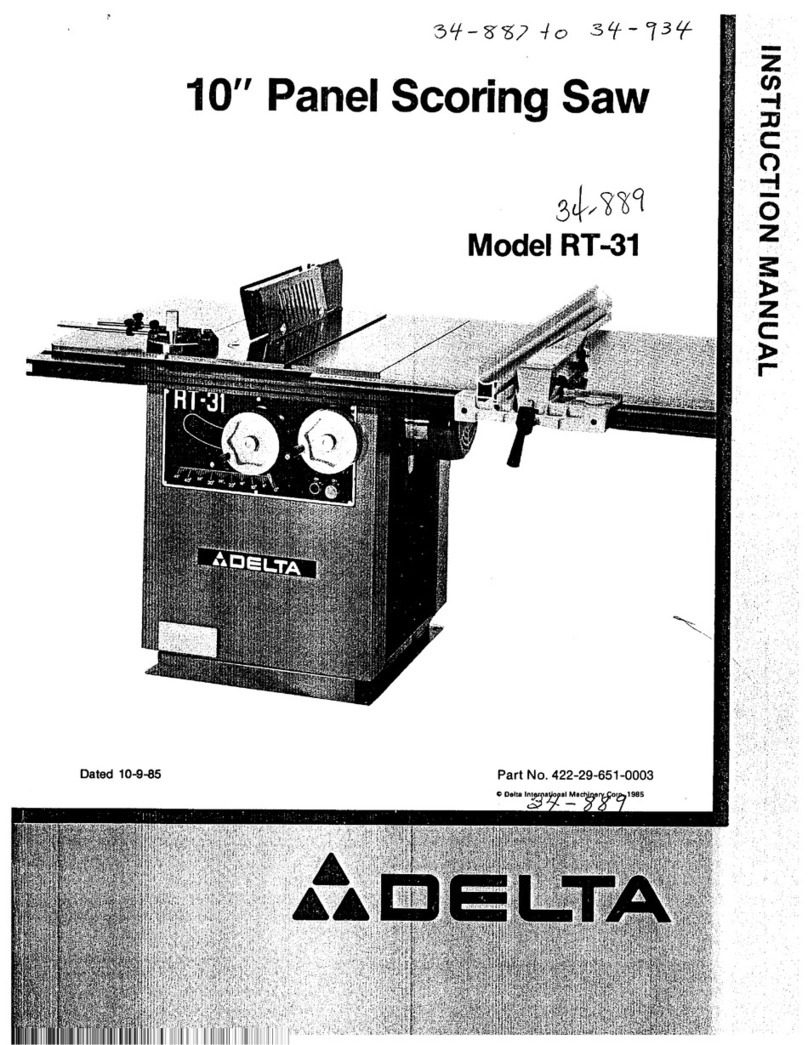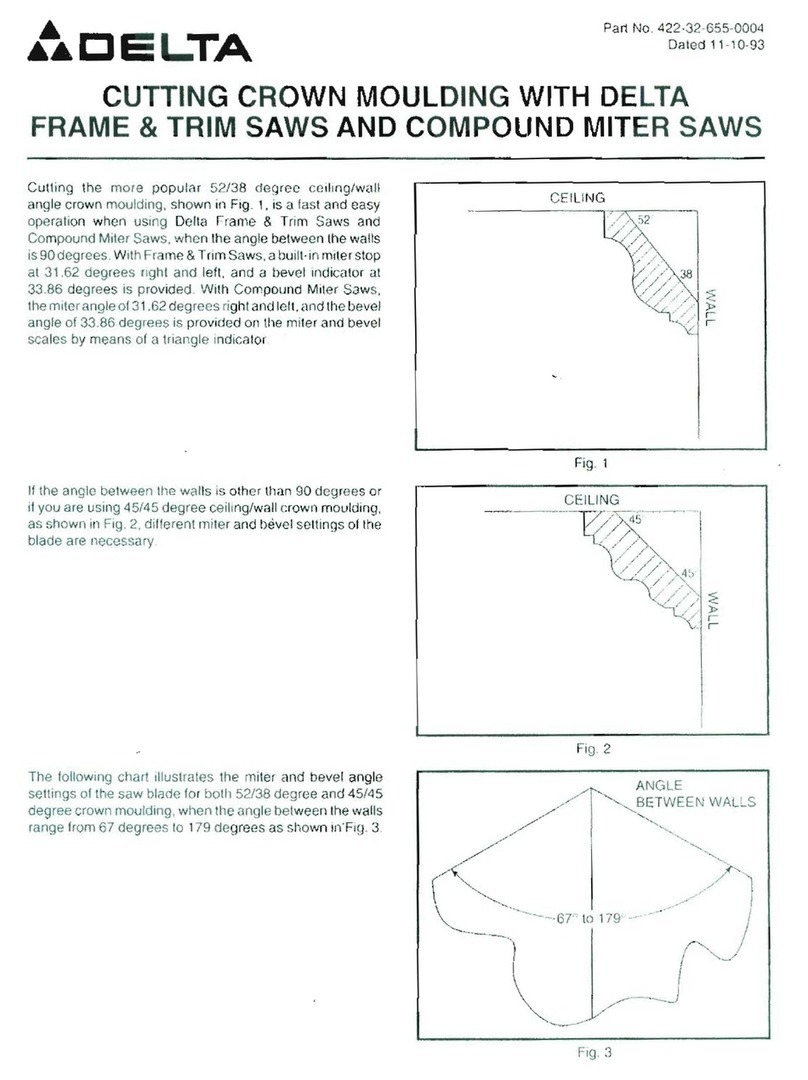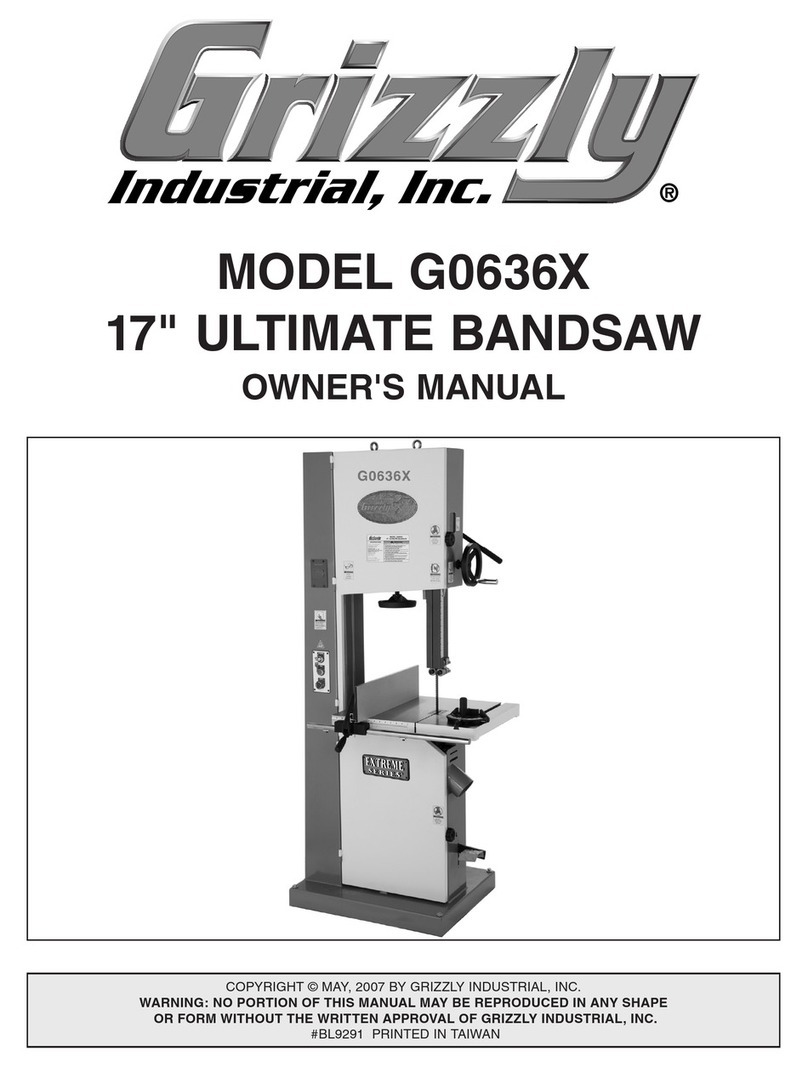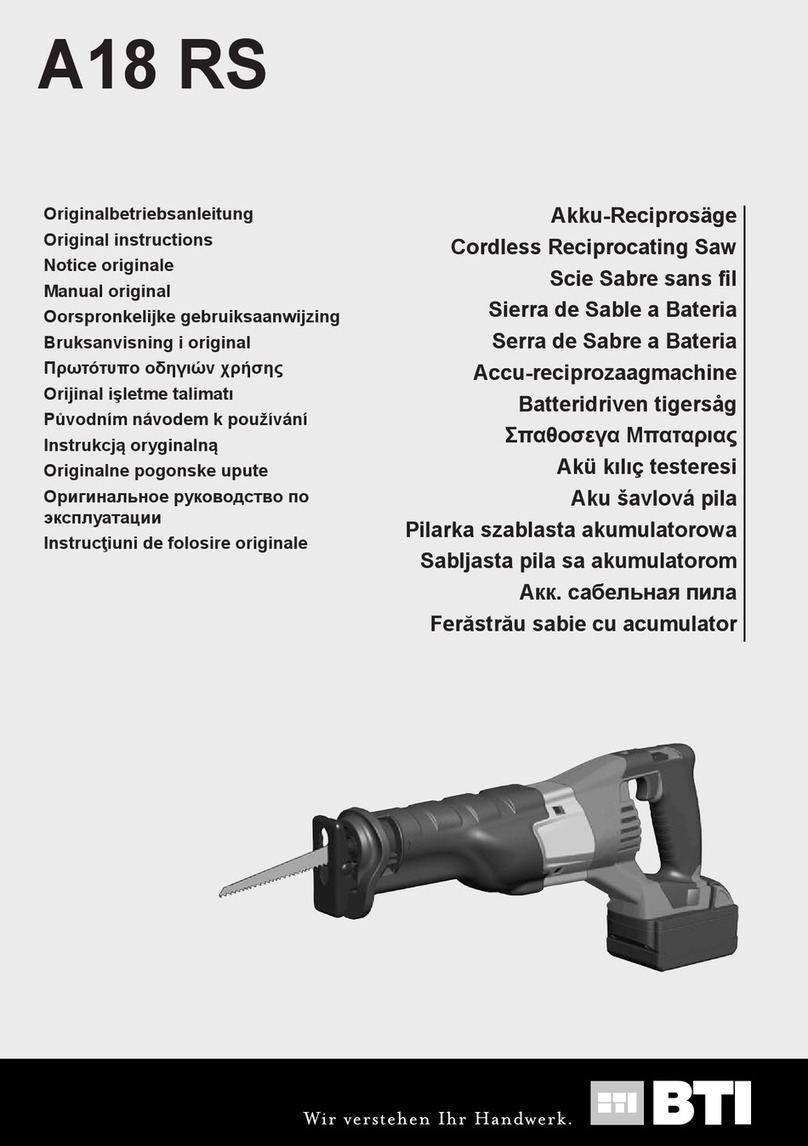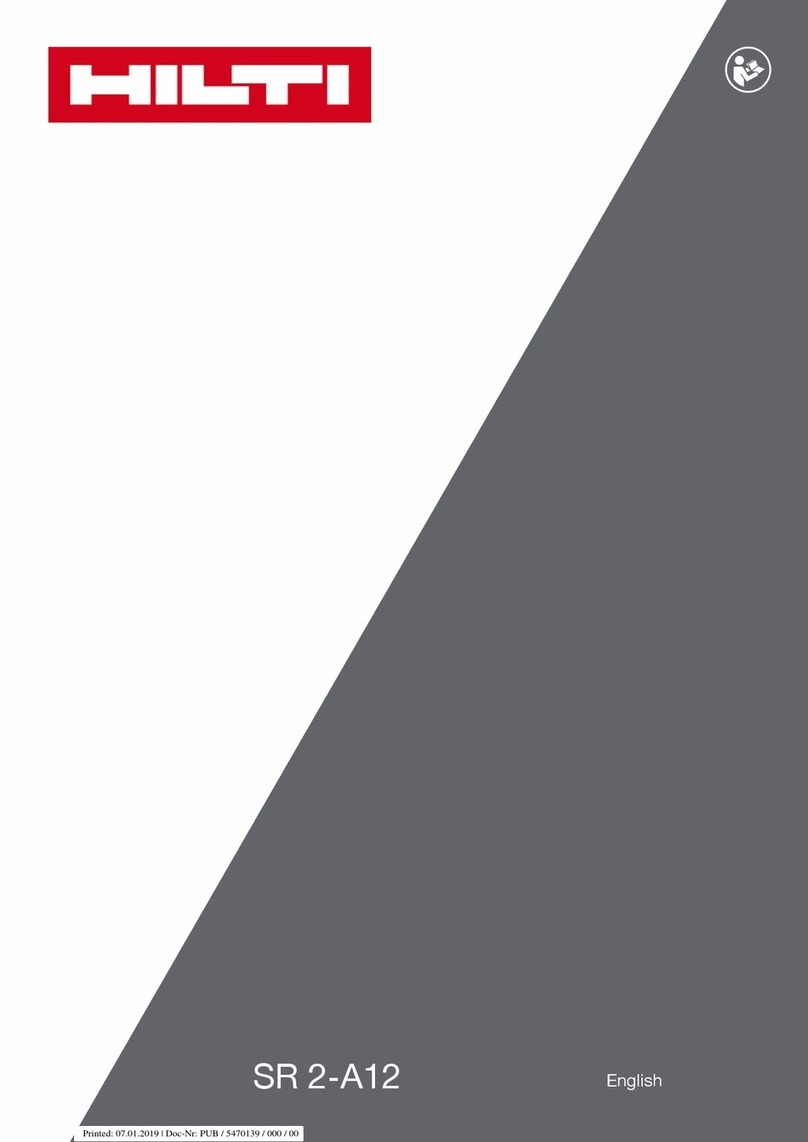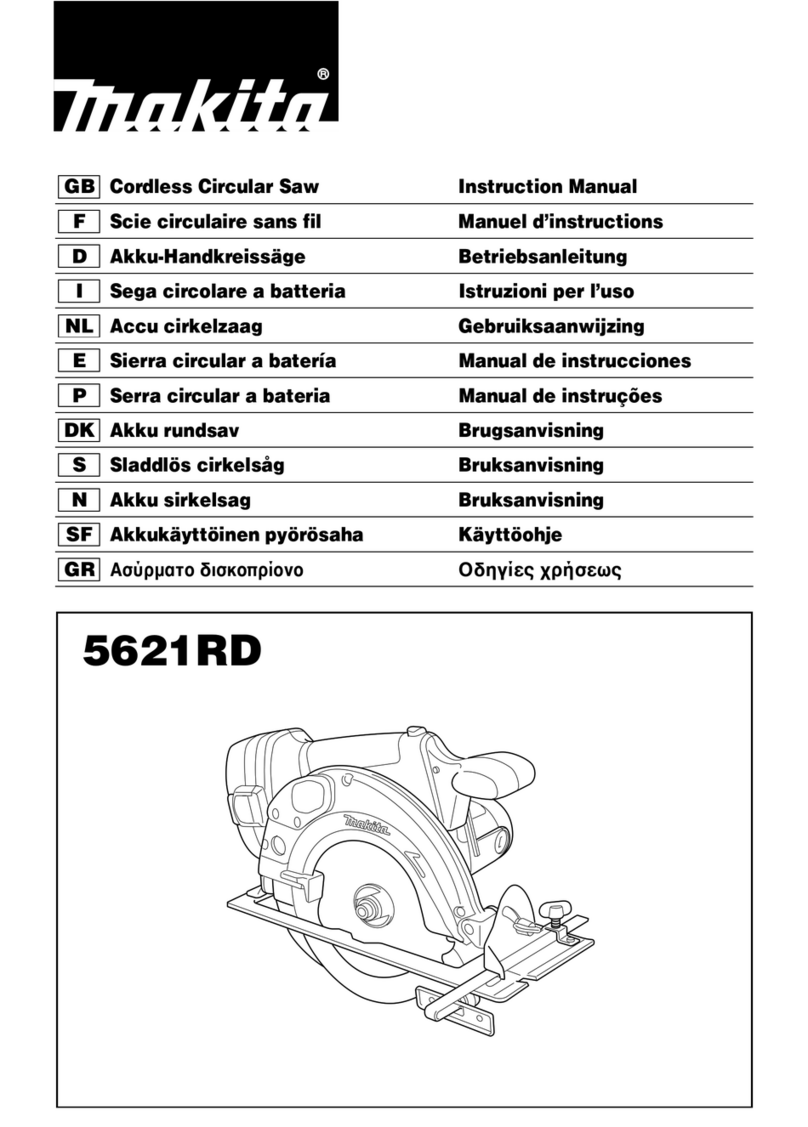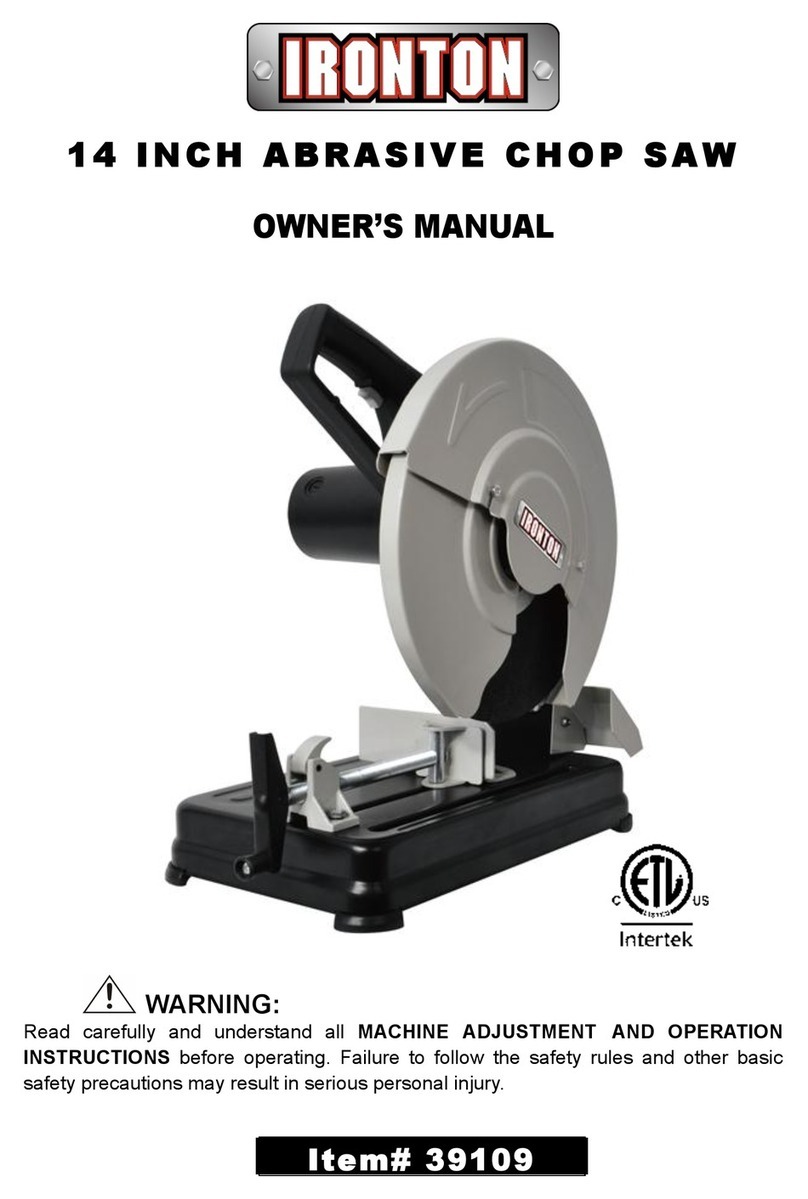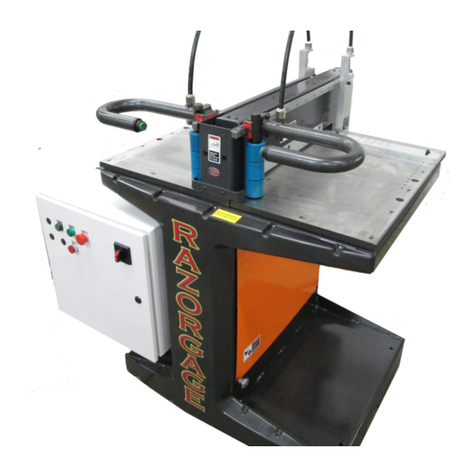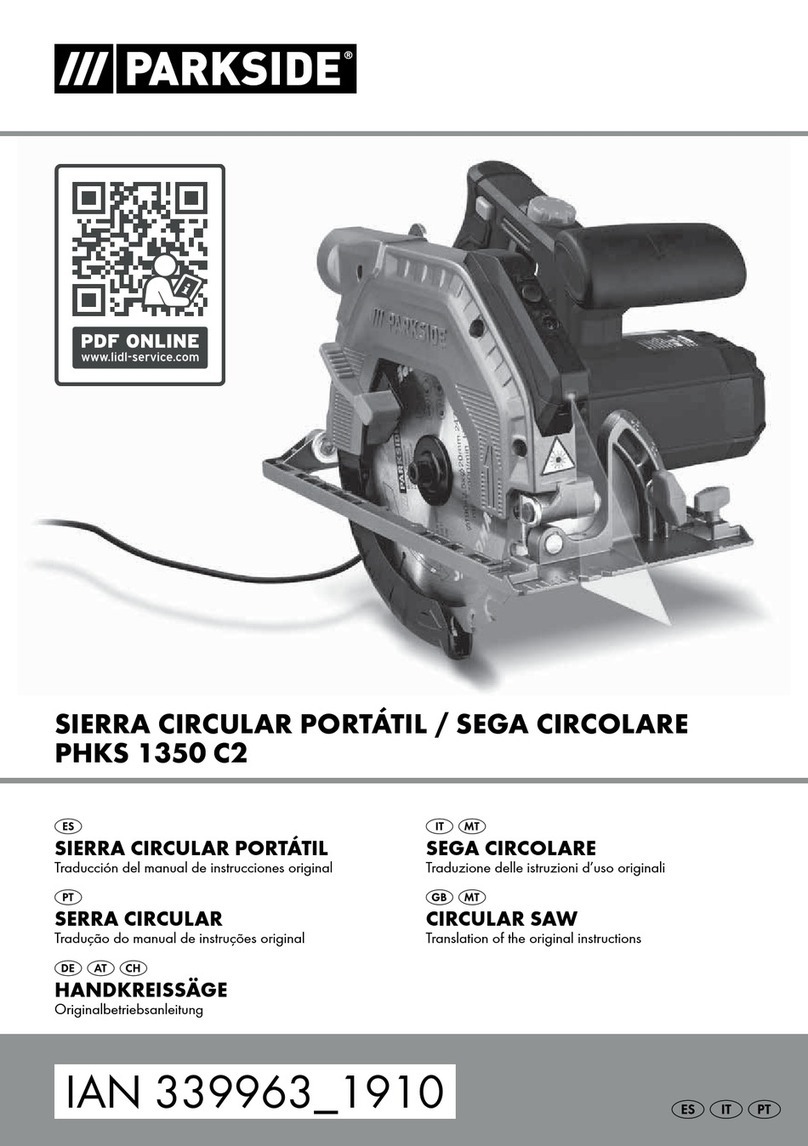Delta 33-830 User manual

10″″Professional Radial Arm Saw
(Model 33-830)
INSTRUCTION MANUAL
PART NO. 424-12-651-0031 (019)
Copyright © 2001 Delta Machinery
ESPAÑOL: PÁGINA 29
To learn more about DELTA MACHINERY
visit our website at: www.deltamachinery.com.
For Parts, Service, Warranty or other Assistance,
please call 1-800-223-7278 (In Canada call 1-800-463-3582).

2
GENERAL SAFETY RULES
Woodworking can be dangerous if safe and proper operating procedures are not followed. As with all machinery, there
are certain hazards involved with the operation of the product. Using the machine with respect and caution will
considerably lessen the possibility of personal injury. However, if normal safety precautions are overlooked or ignored,
personal injury to the operator may result. Safety equipment such as guards, push sticks, hold-downs, featherboards,
goggles, dust masks and hearing protection can reduce your potential for injury. But even the best guard won’t make
up for poor judgment, carelessness or inattention. Always use common sense and exercise caution in the workshop.
If a procedure feels dangerous, don’t try it. Figure out an alternative procedure that feels safer. REMEMBER: Your
personal safety is your responsibility.
This machine was designed for certain applications only. Delta Machinery strongly recommends that this machine not
be modified and/or used for any application other than that for which it was designed. If you have any questions relative
to a particular application, DO NOT use the machine until you have first contacted Delta to determine if it can or should
be performed on the product.
Technical Service Manager
Delta Machinery
4825 Highway 45 North
Jackson, TN 38305
(IN CANADA: 505 SOUTHGATE DRIVE, GUELPH, ONTARIO N1H 6M7)
WARNING: FAILURE TO FOLLOW THESE RULES MAY RESULT IN SERIOUS PERSONAL INJURY
1. FOR YOUR OWN SAFETY, READ INSTRUCTION
MANUAL BEFORE OPERATING THE TOOL. Learn the
tool’s application and limitations as well as the specific
hazards peculiar to it.
2. KEEP GUARDS IN PLACE and in working order.
3. ALWAYS WEAR EYE PROTECTION.
Wear safety
glasses. Everyday eyeglasses only have impact resistant
lenses; they are not safety glasses. Also use face or dust
mask if cutting operation is dusty. These safety glasses
must conform to ANSI Z87.1 requirements. NOTE:
Approved glasses have Z87 printed or stamped on them.
4. REMOVE ADJUSTING KEYS AND WRENCHES. Form
habit of checking to see that keys and adjusting wrenches
are removed from tool before turning it “on”.
5. KEEP WORK AREA CLEAN. Cluttered areas and
benches invite accidents.
6. DON’T USE IN DANGEROUS ENVIRONMENT. Don’t
use power tools in damp or wet locations, or expose them
to rain. Keep work area well-lighted.
7. KEEP CHILDREN AND VISITORS AWAY. All children
and visitors should be kept a safe distance from work area.
8. MAKE WORKSHOP CHILDPROOF – with padlocks,
master switches, or by removing starter keys.
9. DON’T FORCE TOOL. It will do the job better and be
safer at the rate for which it was designed.
10. USE RIGHT TOOL. Don’t force tool or attachment to
do a job for which it was not designed.
11. WEAR PROPER APPAREL. No loose clothing, gloves,
neckties, rings, bracelets, or other jewelry to get caught in
moving parts. Nonslip footwear is recommended. Wear
protective hair covering to contain long hair.
12. SECURE WORK. Use clamps or a vise to hold work
when practical. It’s safer than using your hand and frees
both hands to operate tool.
13. DON’T OVERREACH. Keep proper footing and
balance at all times.
14. MAINTAIN TOOLS IN TOP CONDITION. Keep tools
sharp and clean for best and safest performance. Follow
instructions for lubricating and changing accessories.
15. DISCONNECT TOOLS before servicing and when
changing accessories such as blades, bits, cutters, etc.
16. USE RECOMMENDED ACCESSORIES. The use of
accessories and attachments not recommended by Delta
may cause hazards or risk of injury to persons.
17. REDUCE THE RISK OF UNINTENTIONAL STARTING.
Make sure switch is in “OFF” position before plugging in
power cord.
In the event of a power failure, move switch
to the “OFF” position.
18. NEVER STAND ON TOOL. Serious injury could occur if
the tool is tipped or if the cutting tool is accidentally
contacted.
19. CHECK DAMAGED PARTS. Before further use of the
tool, a guard or other part that is damaged should be
carefully checked to ensure that it will operate properly and
perform its intended function – check for alignment of
moving parts, binding of moving parts, breakage of parts,
mounting, and any other conditions that may affect its
operation. A guard or other part that is damaged should be
properly repaired or replaced.
20. DIRECTION OF FEED. Feed work into a blade or
cutter against the direction of rotation of the blade or cutter
only.
21. NEVER LEAVE TOOL RUNNING UNATTENDED.
TURN POWER OFF. Don’t leave tool until it comes to a
complete stop.
22.
STAY ALERT, WATCH WHAT YOU ARE DOING, AND
USE COMMON SENSE WHEN OPERATING A POWER
TOOL. DO NOT USE TOOL WHILE TIRED OR UNDER
THE INFLUENCE OF DRUGS, ALCOHOL, OR
MEDICATION. A moment of inattention while operating
power tools may result in serious personal injury.
23. MAKE SURE TOOL IS DISCONNECTED FROM
POWER SUPPLY while motor is being mounted,
connected or reconnected.
24. THE DUST GENERATED by certain woods and wood
products can be injurious to your health. Always operate
machinery in well ventilated areas and provide for proper
dust removal. Use wood dust collection systems whenever
possible.
25.
WARNING: SOME DUST CREATED BY
POWER SANDING, SAWING, GRINDING, DRILLING,
AND OTHER CONSTRUCTION ACTIVITIES contains
chemicals known to cause cancer, birth defects or other
reproductive harm. Some examples of these chemicals
are:
· lead from lead-based paints,
· crystalline silica from bricks and cement and other
masonry products, and
· arsenic and chromium from chemically-treated lumber.
Your risk from these exposures varies, depending on how
often you do this type of work. To reduce your exposure
to these chemicals: work in a well ventilated area, and
work with approved safety equipment, such as those
dust masks that are specially designed to filter out
microscopic particles.
SAVE THESE INSTRUCTIONS.
Refer to them often and use them to instruct others.

3
ADDITIONAL SAFETY RULES FOR RADIAL ARM SAWS
1. READ AND UNDERSTAND THE INSTRUCTION
MANUAL BEFORE OPERATING THIS TOOL.
2. DO NOT OPERATE THIS TOOL until it is completely
assembled and installed according to the instructions.
3. OBTAIN ADVICE from your supervisor, instructor, or
some other qualified person if you are not thoroughly
familiar with operating this tool.
4. FOLLOW ALL WIRING CODES/recommended
electrical connections. PROPERLY GROUND the tool.
5. NEVER USE TOOL WITHOUT GUARDS in place.
6. KEEP BLADE SHARP and free of rust and pitch.
7. KEEP BLADE and arbor flanges free from dirt and
grease.
8. SECURELY FASTEN END PLATES TO TRACK
ARM prior to use.
9. TIGHTEN ALL CLAMP HANDLES prior to use.
10.WEAR EYE PROTECTION (safety glasses or face
shield.
11.DO NOT OPERATE while under the influence of
drugs, alcohol, or medication.
12.DO NOT WEAR GLOVES, tie, or loose clothing.
REMOVE RINGS, watch, and other jewelry, and roll up
sleeves.
13.DO NOT cut any workpiece “freehand”.
14.KNOW HOW TO AVOID KICKBACK.
15.USE ANTI-KICKBACK FINGERS when ripping.
Lower the guard on the infeed end and adjust the anti-
kickback attachment properly.
16.USE THE FENCE to support and guide the work.
17.KEEP ARMS AND HANDS OUT OF PATH of the saw
blade.
18.NEVER REACH around the saw blade.
19.NEVER PERFORM a “crossed arm” operation.
20.PROPERLY SUPPORT all long or wide workpieces.
21.NEVER START THE TOOL with the blade engaged
in the workpiece.
22.FOLLOW ALL RIPPING WARNINGS on tool. Never
rip a workpiece from the wrong end.
23.NEVER FEED WORK into the anti-kickback end of
the tool.
24.USE A “PUSH-STICK” for narrow ripping work.
25.REMOVE CUT-OFF PIECES and scraps from the
table before cutting. The vibration of the tool may cause
them to move into the path of the saw blade and be
thrown out. After cutting, and after the blade has come
to a complete stop, turn the tool off and remove all
debris.
26.TURN THE TOOL “OFF” and disconnect the tool
from the power source before adjusting or changing set-
ups.
27.TURN THE TOOL “OFF” and disconnect the tool
from the power source when making repairs.
28.TURN THE TOOL “OFF”, disconnect the tool from
the power source, and clean the table/work area before
leaving the tool.
29.NEVER leave the work area when the power is “ON”,
or before the tool has come to a complete stop.
30.IMPORTANT: When the tool is not in use, the switch
should be locked in the “OFF” position to prevent
unauthorized use.
31.IF ANY PART OF YOUR TOOL IS MISSING,
damaged, or fails, or if any electrical component
performs improperly, shut off the switch and remove the
plug from the power supply. Replace missing, damaged,
or failed parts before resuming operation.
Use proper extension cords. Make sure your extension cord is in good condition and is a 3-wire extension cord
which has a 3-prong grounding type plug and matching receptacle which will accept the tool’s plug. When using an
extension cord, be sure to use one heavy enough to carry the current of the tool. An undersized cord will cause a
drop in line voltage, resulting in loss of power and overheating. Fig. A, shows the correct gauge to use depending on
the cord length. If in doubt, use the next heavier gauge. The smaller the gauge number, the heavier the cord.
EXTENSION CORDS
Fig. A Fig. A
MINIMUM GAUGE EXTENSION CORD
RECOMMENDED SIZES FOR USE WITH STATIONARY ELECTRIC TOOLS
Ampere Total Length Gauge of
Rating Volts of Cord in Feet Extension Cord
0-6 120
up to
25 18 AWG
0-6 120 25-50 16 AWG
0-6 120 50-100 16 AWG
0-6 120 100-150 14 AWG
6-10 120
up to
25 18 AWG
6-10 120 25-50 16 AWG
6-10 120 50-100 14 AWG
6-10 120 100-150 12 AWG
10-12 120
up to
25 16 AWG
10-12 120 25-50 16 AWG
10-12 120 50-100 14 AWG
10-12 120 100-150 12 AWG
12-16 120
up to
25 14 AWG
12-16 120 25-50 12 AWG
12-16 120 GREATER THAN 50 FEET NOT RECOMMENDED
MINIMUM GAUGE EXTENSION CORD
RECOMMENDED SIZES FOR USE WITH STATIONARY ELECTRIC TOOLS
Ampere Total Length Gauge of
Rating Volts of Cord in Feet Extension Cord
0-6 240
up to
50 18 AWG
0-6 240 50-100 16 AWG
0-6 240 100-200 16 AWG
0-6 240 200-300 14 AWG
6-10 240
up to
50 18 AWG
6-10 240 50-100 16 AWG
6-10 240 100-200 14 AWG
6-10 240 200-300 12 AWG
10-12 240
up to
50 16 AWG
10-12 240 50-100 16 AWG
10-12 240 100-200 14 AWG
10-12 240 200-300 12 AWG
12-16 240
up to
50 14 AWG
12-16 240 50-100 12 AWG
12-16 240
GREATER THAN 100 FEET NOT RECOMMENDED

4
POWER CONNECTIONS
A separate electrical circuit should be used for your tools. This circuit should not be less than #12 wire and should be
protected with a 20 Amp time lag fuse. If an extension cord is used, use only 3-wire extension cords which have 3-
prong grounding type plugs and matching receptacle which will accept the tool’s plug. Before connecting the motor to
the power line, make sure the switch is in the “OFF” position and be sure that the electric current is of the same
characteristics as indicated on the tool. All line connections should make good contact. Running on low voltage will
damage the motor.
WARNING: DO NOT EXPOSE THE TOOL TO RAIN OR OPERATE THE TOOL IN DAMP LOCATIONS.
MOTOR SPECIFICATIONS
Your tool is wired for 120 volt, 60 HZ alternating current. Before connecting the tool to the power source, make sure
the switch is in the “OFF” position.
GROUNDING INSTRUCTIONS
WARNING: THIS TOOL MUST BE GROUNDED WHILE IN USE TO PROTECT THE OPERATOR FROM
ELECTRIC SHOCK.
Fig. B
GROUNDED OUTLET BOX
CURRENT
CARRYING
PRONGS
GROUNDING BLADE
IS LONGEST OF THE 3 BLADES
2. Grounded, cord-connected tools intended for use on
a supply circuit having a nominal rating less than 150
volts:
If the tool is intended for use on a circuit that has an outlet
that looks like the one illustrated in Fig. B,the tool will have
a grounding plug that looks like the plug illustrated in Fig.
B. A temporary adapter, which looks like the adapter
illustrated in Fig. C, may be used to connect this plug to a
matching 2-conductor receptacle as shown in Fig. C if a
properly grounded outlet is not available. The temporary
adapter should be used only until a properly grounded
outlet can be installed by a qualified electrician. The
green-colored rigid ear, lug, and the like, extending from
the adapter must be connected to a permanent ground
such as a properly grounded outlet box. Whenever the
adapter is used, it must be held in place with a metal
screw.
NOTE: In Canada, the use of a temporary adapter is not
permitted by the Canadian Electric Code.
3. Grounded, cord-connected tools intended for use on
a supply circuit having a nominal rating between 150 -
250 volts, inclusive:
If the tool is intended for use on a circuit that has an
outlet that looks like the one illustrated in Fig. D. The tool
will have a grounding plug that looks like the plug
illustrated in Fig. D. Make sure the tool is connected to
an outlet having the same configuration as the plug. No
adapter is available or should be used with this tool. If
the tool must be re-connected for use on a different type
of electric circuit, the re-connection should be made by
qualified service personnel; and after re-connection, the
tool should comply with all local codes and ordinances.
WARNING: IN ALL CASES, MAKE CERTAIN THE
RECEPTACLE IN QUESTION IS PROPERLY
GROUNDED. IF YOU ARE NOT SURE HAVE A
QUALIFIED ELECTRICIAN CHECK THE RECEPTACLE.
1. All grounded, cord-connected tools:
In the event of a malfunction or breakdown, grounding
provides a path of least resistance for electric current to
reduce the risk of electric shock. This tool is equipped with
an electric cord having an equipment-grounding
conductor and a grounding plug. The plug must be
plugged into a matching outlet that is properly installed
and grounded in accordance with all local codes and
ordinances.
Do not modify the plug provided - if it will not fit the outlet,
have the proper outlet installed by a qualified electrician.
Improper connection of the equipment-grounding
conductor can result in risk of electric shock. The
conductor with insulation having an outer surface that is
green with or without yellow stripes is the equipment-
grounding conductor. If repair or replacement of the
electric cord or plug is necessary, do not connect the
equipment-grounding conductor to a live terminal.
Check with a qualified electrician or service personnel if
the grounding instructions are not completely understood,
or if in doubt as to whether the tool is properly grounded.
Use only 3-wire extension cords that have 3-prong
grounding type plugs and matching 3-conductor
receptacles that accept the tool’s plug, as shown in Fig. B.
Repair or replace damaged or worn cord immediately.

5
Fig. C
GROUNDED OUTLET BOX
GROUNDING
MEANS
ADAPTER
Fig. D
GROUNDED OUTLET BOX
CURRENT
CARRYING
PRONGS
GROUNDING BLADE
IS LONGEST OF THE 3 BLADES
Fig. E
Fig. F
CHANGING VOLTAGE
The motor supplied with your saw is wired for 120 volt
operation. If you desire to operate your saw at 240 volts,
it is necessary to reposition voltage changing switch in
the motor junction box (B) Fig. E. Proceed as follows:
1. WARNING: DISCONNECT TOOL FROM POWER
SOURCE.
2. Remove screw (A) Fig. E, and remove nameplate
cover (B).
3. Carefully slide switch (C) Fig. F, in motor junction
box to read 240. Replace nameplate cover and screw
which were removed in STEP 2.
4. It is also necessary to replace the 120 volt plug
supplied with the motor with a UL/CSA listed plug
suitable for 240 volts and the rated current of the saw.
Contact your local Authorized Delta Service Center or
qualified electrician for proper procedures to install the
plug. The saw must comply with all local and national
electrical codes after the 240 volt plug is assembled.
BA
C
Fig. G
OVERLOAD PROTECTION
The motor on your saw is equipped with a resettable
overload relay button (D) Fig. G. If the motor shuts off or
fails to start due to overloading, or low voltage, turn the
switch to the “OFF” position, let the motor cool three to
five minutes then push the reset button (D). The motor
can then be turned on again in the usual manner. Some
conditions that may cause overloading are; cutting stock
too fast, using a dull blade, using the saw beyond its
capacity, etc.
D

6
FUNCTIONAL DESCRIPTION
FOREWORD
Delta Model 33-830 is a 10" (254mm) Professional Radial Arm Saw with maximum cutting capacity of 16" (406mm)
crosscut, 2-3/4" (70mm) depth at 90° and 2-1/2" (64mm) depth at 45° bevel. It is designed with positive bevel stops at
0°, 45° and 90° and positive miter stops at 0° and 45° both right and left. Unit includes; 1-1/2 hp 120/240V motor,
automatic blade brake, saw blade, wrenches, steel stand, cast-iron track and extra-large table.
UNPACKING AND CLEANING
Carefully unpack the tool and all loose items from the shipping container(s). Remove the protective coating from all
unpainted surfaces. This coating may be removed with a soft cloth moistened with kerosene (do not use acetone, gasoline
or lacquer thinner for this purpose). After cleaning, cover the unpainted surfaces with a good quality household floor paste
wax.
NOTICE: THE MANUAL COVER PHOTO ILLUSTRATES THE CURRENT
PRODUCTION MODEL. ALL OTHER ILLUSTRATIONS ARE REPRESENTATIVE
ONLY AND MAY NOT DEPICT THE ACTUAL COLOR, LABELING OR
ACCESSORIES.
1. The saw is packed at the factory with support
blocks (A) Fig. 1, under the cutter-head (B), and track
arm (C). Shipping boards (D) Fig. 1 are fastened to saw
base (G). To prevent damage during shipment, the track
arm elevating knob (H) is disassembled from lever (E).
Before proceeding, insert post of knob (H) Fig. 2,
through hole in lever (E) and assemble E-ring (K), to slot
in post.
2. The support blocks (A) Fig. 1, can be removed by
rotating track arm elevating knob (H) clockwise and the
shipping boards (D) can be removed by removing hold-
down screws (not shown), which are located inside saw
base. Discard the support blocks (A) and shipping boards
(D).
3 Fig. 3, illustrates the saw with support blocks and
shipping boards removed.
Fig. 1
Fig. 3Fig. 2
D
A
G
B
H
C
K
E
H
E

7
Fig. 4
Fig. 5
1. 10″Professional Radial
Arm Saw
2. Left and right
table supports
3. 5/16-18 x 5/8″Carriage
Head Screws (16)
4. 5/16″Flat Washers (16)
5. 5/16″External Tooth
Lockwashers (16)
6. 5/16″Hex Nuts (16)
7. Legs (4)
8. Front Table Board
9. Rear Table Board
10. Middle Table Board
11. Fence Board
12. 1/4-20 Flange Nuts (4)
13. 1/4-20 x 1″Truss
Head Screws (4)
14. Wrenches
15. 1/4-20 x 1-1/4″Pan
Head Screws (4)
16. 5/16-18 x 5/8″Carriage
Head Screws (6)
17. 5/16″Flange Nuts (6)
18. Wrench Hook
19. #10 x 1/2″Screw (2)
20. Table Board Clamp
Assembly (2)
1
7
4
6
3
5
2
11
10
9
8
20 19 18
17
16 15 12
13
14
COMPONENTS OF THE 10" PROFESSIONAL RADIAL ARM SAW
ILLUSTRATED IN FIGS. 4 AND 5

8
EXPLANATION OF OPERATING CONTROLS
The following is an explanation of the operating controls of the Delta 10" Radial Saw. We suggest you study these
explanations carefully to familiarize yourself with the controls before turning on the power. Doing otherwise may cause
damage to the saw or personal injury (Figs. 6 and 7).
A. TABLE CLAMP KNOBS. Allows the operator to quickly
set the desired fence position. Fig. 6
B. TRACK ARM INDEXING RELEASE HANDLE. Releases
the indexing pin from the 0 degree and 45 degree positions
to allow the arm to rotate. Depress handle to release the
index pin. Fig. 6
C. TRACK ARM ELEVATING HANDLE. Controls the depth-
of-cut in all operations. Turn the handle clockwise to raise or
counterclockwise to lower the track arm. Fig. 6
D. MITER SCALE. Indicates degrees left and right for setting
track arm to desired miter angle. Fig. 6
F. RIP SCALE. Indicates the in and out rip positions of the
cutter-head. Fig. 6
G. BLADE GUARD CLAMP KNOB. Clamps the blade guard
at rotated positions for ripping. Fig. 6
H. BEVEL CLAMP HANDLE. Controls tilt of motor for bevel
cutting operations. Locks motor at any desired angle on the
bevel scale. Lift handle to loosen and push down to lock.
Fig. 6
J. BEVEL INDEX RELEASE KNOB. Locates 0 degree,
45 degree, and 90 degree. Positions the motor for bevel
setting. When tilting the motor for bevel cutting, the bevel
clamp handle must first be loosened. To release the index
pull out on the release knob. Fig. 6
K. YOKE INDEXING RELEASE LEVER. Locates each 90
degree position of the yoke for ripping or cross-cutting
operations. When rotating the yoke, the yoke clamp handle
must first be loose. Push the release lever either up or down
to release the indexing pin. Fig. 6
L. YOKE CLAMP HANDLE. The yoke clamp handle must
be loose when rotating the yoke between the rip and cross-
cutting position. Pull the handle to release and push it to
lock. Fig. 7
M. ANTI-KICKBACK DEVICE. When ripping, the yoke is
positioned and clamped so that the blade is parallel to the
fence. The rear of the blade guard is rotated until it almost
touches the workpiece. The anti-kickback rod is then
lowered so that the fingers catch and hold the workpiece.
Never rip from the anti-kickback end of the blade guard.
Fig. 7
N. ON-OFF SWITCH. Conveniently located switch can be
turned on or off in an instant for added operation
protection. Switch also can be locked in the off position to
prevent unauthorized use using an accessory padlock.
Fig. 7
P. CUTTING-HEAD CLAMP KNOB. Locks cutting-head at
any position on the track arm. When ripping the cutting-
head, clamp knob must be tight. Fig. 7
R. BEVEL SCALE. Indicates degrees of rotation for setting
motor bevel positions. Fig. 7
S. TRACK ARM CLAMP HANDLE. Controls rotation of
track arm for all miter cutting operations. Locks track arm
at any miter angle position. To rotate track arm to the right,
loosen clamp handle and rotate arm. The arm will stop at
45 degrees. To rotate past 45 degrees, depress indexing
release handle and continue to rotate; arm will only rotate
an additional 5 degrees. To rotate to the left, the operation
is the same except the indexing release handle must be
depressed to start rotating. Fig. 7
Fig. 6
A
J
D
KG
F
H
CB
Fig. 7
S
L
N
M
R
P

9
ASSEMBLY
TOOLS NEEDED FOR ASSEMBLY AND ADJUSTMENT
Your Delta Radial Arm Saw can be assembled and adjusted using a few common hand tools, including:
• Phillips head screwdriver • 7/16″Wrench • 1/2″Socket, ratchet, and extension • 3/16″Allen Wrench
• Flat blade screwdriver • 1/2″Wrench • Adj. Combination Square • 1/4″Allen Wrench
• Framing Square
ASSEMBLING LEGS TO SAW BASE
Fig. 8
Fig. 9
Fig. 10
1. Loosen lock knob (A) Fig. 8, and move cutting-head
(B) to the rear position as shown. Then tighten knob (A).
2. IMPORTANT: Make certain the cutting-head is
clamped securely at the back of the track arm.
3. Place Radial Arm Saw on its back and assemble legs
(C) Fig. 9 (three of which are shown assembled) to each
corner of saw base (D) using sixteen 5/16-18 x 5/8″
carriage head screws (E), flat washers (G), external tooth
lockwashers (H), and hex nuts (J). Place flat washer on
bolt. Insert bolt through holes then assemble lockwasher
and nut. Hand tighten, hardware at this time but do not
completely tighten. Also refer to hardware Fig. 4.
4. Stand the saw in the upright position and securely
tighten all stand hardware.
ASSEMBLING WRENCH
HOOK TO SAW BASE
1. Assemble wrench hook (K) Fig. 10, to the front right
(as shown), or back left, side of saw base (D), using two
#10 x 1/2″shet metal screws.
A
B
C
D
C
G
J
H
E
D
K

10
Fig. 11
Fig. 12
Fig. 13
Fig. 14
REMOVING BLADE AND
BLADE GUARD FROM SAW
1. DISCONNECT TOOL FROM POWER SOURCE.
2. Loosen blade guard clamp knob (A) Fig. 11, and
rotate blade guard (B) to the position shown.
3. With wrenches supplied (C) Fig. 12, loosen arbor nut
(D) as much as possible. NOTE: Arbor nut has left
hand threads.
4. Lift cam (E) Fig. 13, which holds the blade guard (B)
Fig. 12, in position and move the blade guard (B), outer
blade flange (F), and blade (G) outward.
5. Lift blade guard (B) Fig. 14, and remove arbor nut
(D), outer blade flange (F), and blade (G). Then remove
blade guard (B).
A
B
B
F
C
G
D
E
B
G
FD

11
Fig. 15
Fig. 16
Fig. 17
Fig. 18
ASSEMBLING TRACK ARM
CLAMP LEVER
1. Assemble track arm clamp lever (A) Fig. 15, by
threading into clamp lock nut (B).
ASSEMBLING
AND ADJUSTING
TABLE SUPPORTS
1. Place front table board (A) Fig. 16, on a stable
surface with counterbored holes facing down, as shown.
2. Fasten left and right table supports (B) Fig. 16, to
bottom of front table board (A) as shown, by inserting
four 1/4-20 x 1″long truss head screws (C) up through
counterbored holes (D) in table board (A) and table
supports (B). Secure in place using four flanged hex nuts
(E). Do not completely tighten nuts at this time.
3. Place front table board (A) Fig. 17, onto saw base
(G), so that table supports (B) straddle the outside of
saw base (G) and three holes (H) in each table support
(B) line up with three slots (J) in each side of saw base
(G) as shown.
4. Secure table supports, one of which is shown at
(B) Fig. 18, to each side of saw base using six 5/16-18 x
5/8″long carriage head screws (K) and six flanged hex
nuts (L). Do not completely tighten nuts at this time.
IMPORTANT: Insert screws through saw base table
supports from the inside and place flanged nuts on
screw on engaged side of base as shown.
B
A
B
A
CE
D
D
G
J
B
H
A
B
L
K

12
5. Using a combination square (M) Figs. 19 and 20,
check the left and right front edge of table board (A) to
make certain both sides are the same distance from the
edge of each table support (B) Fig. 20.
Fig. 19
Fig. 20
Fig. 21
Fig. 23Fig. 22
6. When both right and left edges of the table board
are the same distance from the table supports, tighten
four screws located in holes (N) Fig. 21, of front table
board (A).
7. Insert four 1/4″-20 x 1-1/4″long pan head screws
(P) Figs. 21 and 22, into holes (R) Fig. 21, of table board
as shown, and tighten each of the screws until each
corner of the table board raises approximately 1/8″.
8. Loosen bevel clamp lever (S) Fig. 23, pull out bevel
index knob (T), and rotate motor (V) to the vertical
position as shown, until bevel index engages. Then
tighten bevel clamp lever (S). NOTE: If the motor shaft
contacts the table board before the motor is fully
rotated, raise the track arm (X) Fig. 24, by turning
elevating handle (C).
9. Loosen cutting-head clamp knob (W) Fig. 23, and
move cutting-head to the front of track arm (X). Then
tighten cutting-head clamp knob (W).
AM
B
AM
R
R
N
N
PP
N
N
R
R
P
P
A
P
A
P
W
S
X
T
V

13
Fig. 24
Fig. 25
Fig. 26
Fig. 28Fig. 27
10. Loosen track arm clamp handle (Y) Fig. 24. NOTE:
Track clamp handle (Y) has left handed threads. Press
down on indexing release handle (Z) and pivot track arm
(X) to the left until motor shaft (B) Fig. 25, is near front left
adjustment screw (P) of table board (A) as shown. Then
tighten track arm clamp handle (Y) Fig. 24.
11. Place an arbor wrench (D) Fig. 25, between table
board (A) and motor shaft (B). Lower track arm (X)
Fig. 24, by turning elevating handle (C) counterclockwise
until motor shaft (B) Fig. 25, barely touches arbor
wrench.
12. Check the height of the table board above the other
three table board adjustment screws (E) Fig. 26, by re-
positioning track arm (X), and cutting-head assembly (V)
until the highest point of the table is determined. NOTE:
MAKE CERTAIN CUTTING-HEAD CLAMP KNOB (W)
FIG. 27 AND TRACK ARM CLAMP HANDLE (Y) ARE
TIGHTENED WHEN MOTOR SHAFT IS LOCATED
ABOVE EACH OF THE ADJUSTMENT SCREWS. DO
NOT CHANGE HEIGHT OF TRACK ARM (X) FIG. 26,
UNTIL HIGHEST SCREW IS DETERMINED, AND ALL
FOUR CORNERS OF THE TABLE BOARD HAVE BEEN
ADJUSTED.
13. Position the motor shaft back over the three lower
corners of the table board and adjust the table
adjustment screws (E) Fig. 26, until the arbor wrench fits
accordingly between the arbor shaft and table board in
each location.
14. Once the table board (A) Fig. 28, is properly ad-
justed, tighten three nuts (G) on each side of saw base
(H). Then return track arm (X) and motor (V) to the
90 degree position as shown, and tighten bevel clamp
lever (S) and track arm clamp handle (Y) Fig. 27.
W
C
X
Y
Z
D
A
P
B
X
V
E
Y
W
A
S
V
H
GG
X

14
Fig. 29
Fig. 30
Fig. 31
Fig. 32
ASSEMBLING
TABLE BOARD CLAMPS
AND TABLE BOARDS
1. Locate table board clamps (A) Fig. 29, and insert
one clamp into each of the slotted holes (B) located at
the rear of each table support bracket (C) as shown in
Fig. 30.
2. Adjust clamps (A) Fig. 30, so that the clamps are
open entirely as shown, by turning knobs (D).
3. Place 1-1/4″wide board (E) Fig. 31, against front
table board (G), 1-3/4″wide board (H) in the upright
position against 1-1/4″board, and 5-3/4″wide board (J)
against 1-3/4″wide board as shown. Then tighten knobs
(D), until the table boards are securely clamped in
position.
ADJUSTING
AND CHECKING
SAW BLADE TRAVEL
SQUARE TO FENCE
1. DISCONNECT TOOL FROM POWER SOURCE.
2. Position rear and middle table boards with 1-3/4″
wide fence board (H) Fig. 32, in the rear position as
shown.
3. Raise track arm (A) Fig. 32, by turning elevating
handle (B) until the blade (C) can be assembled on the
motor shaft. Then tighten arbor nut (D) using the
wrenches supplied.
4. Place a framing square (E) Fig. 32, against fence (H)
and blade (C) as shown, and lower track arm (A) until the
blade just clears the table surface.
A
B
C
D
A
A
D
G
H
E
J
D
D
H
E
C
D
A
B

15
Fig. 33
Fig. 34
Fig. 35
Fig. 36
5. Loosen cutting-head clamp knob (S) Fig. 33, and
slide cutting-head (T) the entire length of track arm (A) as
shown to determine if blade (C) travels parallel to the
square (E).
6. If an adjustment is necessary, loosen index ring
locking screw (J) Fig. 34, and track arm clamp handle
(K).
7. Rotate track arm (A) Fig. 33, until blade (C) travels
parallel to square (E). Then tighten track arm clamp
handle (K) Fig. 34.
8. With track arm clamp handle (K) Fig. 35, tightened,
rotate index ring (L) counterclockwise until it stops. Then
tighten index ring locking screw (J) Fig. 36.
9. There are two miter index pointers, one of which is
shown at (M) Fig. 36. Adjust as follows: loosen screw (N)
and move pointer (M) until it lines up with the “zero”
mark on the miter scale (P). Then tighten screw (N).
Adjust the miter index pointer located on the other side
of column (R) in the same manner.
A
C
E
T
S
K
J
L
K
N
MP
J
R

16
Fig. 37
Fig. 38
Fig. 39
Fig. 40
REMOVING “HEELING”
IN SAW BLADE CUT
Even though the cutting-head travel may be perfectly
aligned at 90 degrees to the fence, the blade itself may
not be 90 degrees or square with the fence, as shown in
Fig. 37. This condition is known as “heeling.”
To check and adjust, proceed as follows:
1. DISCONNECT TOOL FROM POWER SOURCE.
2. Install saw blade without guard.
3. Replace the fence with a flat piece of 3/4″wood (A)
Fig. 38, at least 5″high. Tighten table board clamps.
4. Place three identical pieces of wood (B) Fig. 38, on
the table and lay a framing square on them so that the
short arm is flush against the fence and the long arm is
against the blade as shown. Be sure square is between
the teeth of the blade.
5. If the blade is not parallel to the square, an
adjustment is necessary. Release the yoke clamp handle
(C) Fig. 39, and slightly loosen two hex head screws (D).
Swivel the yoke until the blade is parallel with the square
and tighten yoke clamp handle (C). Then tighten two hex
screws (D) Fig. 39.
CHECKING AND ADJUSTING
SAW BLADE SQUARE
TO TABLE
1. DISCONNECT TOOL FROM POWER SOURCE.
2. Assemble the inner blade flange, saw blade, outer
blade flange, and arbor nut on saw arbor.
3. Place the cutting-head in a cross-cut position as
shown in Fig. 41. Lower track arm until the saw blade is
just clear of the table and slide the cutting-head forward
until it is positioned over the front table board; clamp the
cutting-head in position as shown in Fig. 41.
4. Make certain the bevel index knob (A) Fig. 40, is
engaged and the motor is in a horizontal position.
Tighten bevel clamp handle (C).
A
BB
C
D
EA
C
F
F
B

17
Fig. 41
Fig. 42
Fig. 43
5. Place a square (D) Fig. 41, on the table and against
the saw blade, as shown, and check to see if the blade
is square with the table. NOTE: The square should rest
between two teeth of the saw blade.
6. If an adjustment is necessary, make certain bevel
clamp lever (C) Fig. 40, is tight. Remove screw, flat
washer, and pointer (E) Fig. 40. Remove two screws (F)
Fig. 40, and bevel scale plate (H) Fig. 42, with index
knob (A).
7. Loosen four hex head screws (G) Fig. 42. Tilt the
motor until the saw blade is flush with the square.
Tighten four hex head screws (G).
8. Replace bevel scale plate (H) Fig. 42, with bevel
index release knob (A), two screws, and pointer that
were removed in STEP 6. NOTE: Adjust pointer to
“zero” on the bevel index scale.
1. DISCONNECT TOOL FROM POWER SOURCE.
2. Loosen yoke clamp handle (A) Fig. 43. Release yoke
index by pressing yoke indexing release lever (B) up or
down, and rotating cutting-head (C) to the in-rip
position as shown. Tighten yoke clamp lever (A).
3. Position fence (D) Fig. 43, at the rear of table as
shown.
4. Loosen cutting-head clamp knob (G) Fig. 48 and
slide cutting-head (C) Fig. 43, to rear of track arm until
saw blade (F) is flush against fence (D).
5. Tighten cutting-head clamp knob (G) Fig. 48 and
adjust pointer (H) Fig. 43, if necessary, to “zero” mark on
lower scale (J) by loosening screw (K). After adjustment
is made, tighten screw (K).
D
G
A
H
AJ
K
C
D
F
BH
ADJUSTING IN/OUT RIP SCALE

18
Fig. 44
Fig. 45
Fig. 46
Fig. 47
ASSEMBLING BLADE AND
BLADE GUARD TO MACHINE
1. DISCONNECT TOOL FROM POWER SOURCE.USE
ONLY 10″″BLADES WITH 5/8″″ARBOR HOLES AND
RATED FOR 5000 RPM OR HIGHER.
2. Assemble the inside (thick) arbor flange (A) Fig. 44,
onto the arbor shaft with the recessed side of flange (A)
facing out.
3. With the blade guard (B) Fig. 45, in the left hand,
insert saw blade (C) into the blade guard (B) and onto
the arbor shaft.
4. Assemble the outside (thin) blade flange (D) Fig. 45,
with the recessed side of flange (D) facing in and arbor
nut (E) onto the arbor shaft. NOTE: ARBOR NUT (E)
FIG. 45, HAS A LEFT HAND THREAD.
5. Lift cam (F) Fig. 46, and assemble blade guard (B)
onto cutting-head assembly. NOTE: MAKE CERTAIN
TONGUE ON GUARD SEATS INTO GROOVE OF
CUTTING-HEAD.
6. Rotate blade guard (B) Fig. 47, to the rear and
tighten arbor nut (E) using two wrenches (G) supplied.
7. Rotate blade guard (B) Fig. 46, to the horizontal
position and tighten clamp knob (H). IMPORTANT:
CLAMP KNOB (H) FIG. 46, MUST BE TIGHT AND
BLADE GUARD SECURE DURING OPERATION.
NOTE: The lower retractable blade guard provides
operator protection in an axial direction to the saw
blade. Care must be taken to eliminate potential hazards
of the lower blade guard.
A) KEEP YOUR HANDS AWAY FROM THE
GUARD. As the blade cuts, the guard will lift
and leave part of the blade exposed.
B) SHUT OFF POWER BEFORE FREEING A
JAMMED LOWER GUARD. The guard can get
jammed in previous kerfs in table or fence.
Always anticipate the path of the guard.
C) USE CAUTION when making bevel cuts to be
sure the lower guard is never pinched towards
the blade.
D) THE LOWER GUARD CAN JAM AGAINST
THE FENCE DURING NARROW IN-RIPS.
Should the guard jam against the fence, dis-
connect the saw from power, wait for the blade
to stop, then lift the blade guard and rest it on
top of the fence.
A
E
B
D
C
H
B
F
B
EG

19
FASTENING SAW TO THE FLOOR
If during operation there is any tendency for the saw to tip over, slide, or walk on the supporting surface, the
saw should be secured to the floor surface through holes provided on the bottom of each leg.
Fig. 48
Fig. 49
Fig. 51Fig. 50
CUTTING INTO
TABLE BOARDS
1. Assemble table boards (A) Fig. 48, and fence (B) as
shown and secure in place with table clamps, one of
which is shown at (C).
2. Return cutting-head (D) Fig. 49, to rear of track arm
(E), and tighten cutting-head clamp knob (G) Fig. 48.
Make sure switch (H) Fig. 49, is in the “OFF” position
and connect saw to power source.
3. While holding cutting-head handle (L) Fig. 49 firmly,
turn switch (H) “ON” and lower track arm (E) by turning
elevating handle (K) as shown. Lower saw blade until it
cuts into the table surface approximately 1/16″deep.
Then stop turning elevating handle (K).
4. While still holding cutting-head handle (L) Fig. 50
firmly, loosen cutting-head clamp knob (G) Fig. 48, and
slowly pull cutting-head (D) Fig. 50, toward the front of
the track arm (E) as shown, until travel stops. Then turn
switch (H) “OFF”.
5. Once saw blade (M) Fig. 51, has come to a complete
stop, return cutting-head (D) to rear of track arm (E) as
shown. Fig. 51, illustrates saw kerf (N) cut into table boards.
IMPORTANT: THE TRACK ARM (E) FIG. 51, MUST BE
RAISED BEFORE ATTEMPTING TO ROTATE IT. ALSO,
THE PROCEDURE “CUTTING INTO TABLE BOARDS”
MUST BE PERFORMED FOR EACH ANGLE CUT
DESIRED.
B
C
A
G
K
E
L
H
D
E
L
H
D
D
M
E
N

20
Fig. 62
Fig. 63
ADJUSTING BALL
BEARINGS AGAINST TRACK
The cutting-head (C) Fig. 61, is suspended from four
pre-loaded, lubricated, shielded ball bearings, two of
which are on fixed shafts at (A) , and two on adjustable
shafts at (B). NOTE: CUTTING-HEAD (C) FIG. 61, IS
REMOVED FROM TRACK ARM FOR ILLUSTRATION
PURPOSES ONLY. DO NOT REMOVE CUTTING-HEAD
FROM TRACK ARM!
After extended use, wear may develop in the track arm,
causing “play” between the ball bearings and the track.
The ball bearings must ride smoothly and evenly in the
channels of the track arm. Adjustment to the two
bearings on adjustable shafts can be made as follows:
1. DISCONNECT TOOL FROM POWER SOURCE.
2. Remove plastic plug (D) Fig. 62, from the top of
track arm (E).
3. Slide cutting-head (C) Fig. 63, until one of the ad-
justable bearings (B) Fig. 60, are visible through hole (G)
Figs. 62 and 63.
4. Using a 1/2″socket, extension, and ratchet (H) Fig.
63, through hole (G) in track arm, slightly loosen hex nut
on adjustable shaft (B) Fig. 61, approximately 1/8 turn.
Repeat procedure for other bearing.
E
D
G
H
G
C
Fig. 61
B
B
A
C
K
Fig. 56
ON/OFF SWITCH
The on/off switch (A) Fig. 56, is located at the front of the
cutting-head. To turn the saw “ON” move the switch (A)
Fig. 56, to the up position. To turn the saw “OFF” move
the switch (A) Fig. 56, to the down position.
IMPORTANT: WHEN THE TOOL IS NOT IN USE, THE
SWITCH SHOULD BE LOCKED IN THE “OFF”
POSITION TO PREVENT UNAUTHORIZED USE. This
can be done by inserting a padlock (D) Fig. 57, through
the holes in switch plate (B) and handle (C) as shown.
Padlock (D) Fig. 57, is available as an accessory.
MOTOR
Your Delta Radial Arm Saw is equipped with a dual
voltage motor capable of 120 volt, single phase
operation or 240 volt, single phase operation. The motor
on your saw is shipped from the factory wired for 120
volt operation. The motor has a built in brake which
automatically stops the blade within seconds after
turning off the saw or when power is lost.
A
B
D
C
Fig. 57
OPERATING CONTROLS AND ADJUSTMENTS
Table of contents
Other Delta Saw manuals
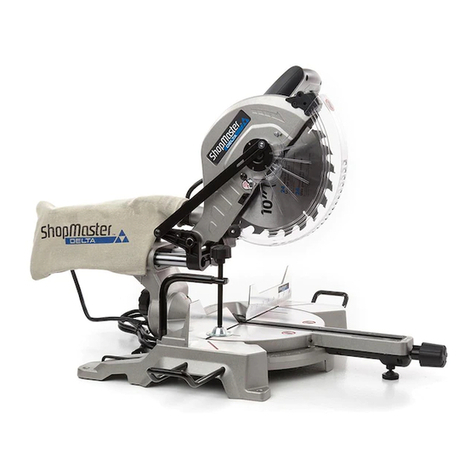
Delta
Delta ShopMaster S26-262LS User manual
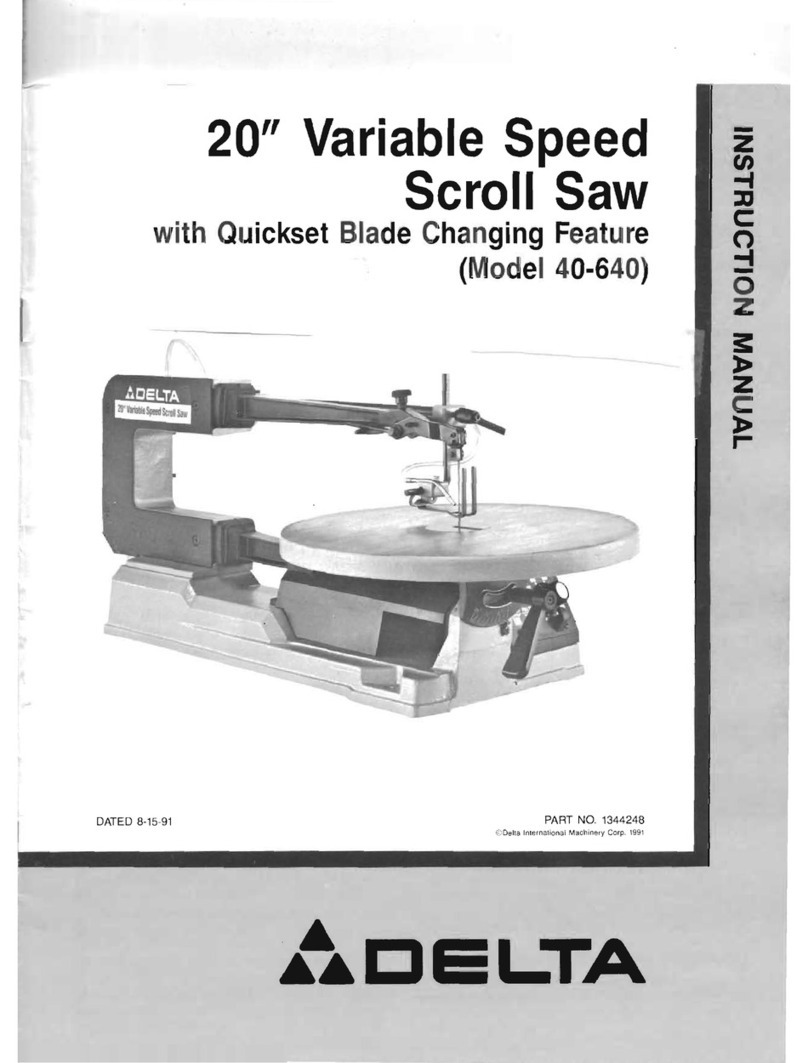
Delta
Delta 40-640 User manual
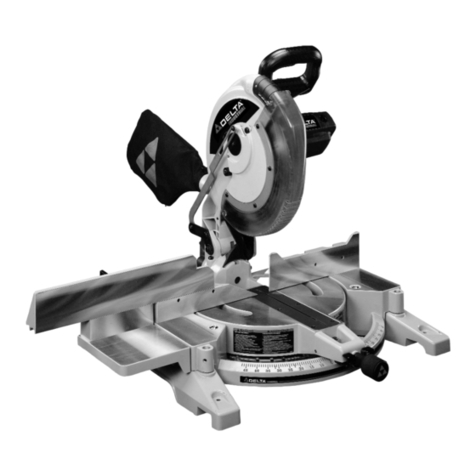
Delta
Delta TwinLaser 36-255L User manual

Delta
Delta 36-5000 User manual
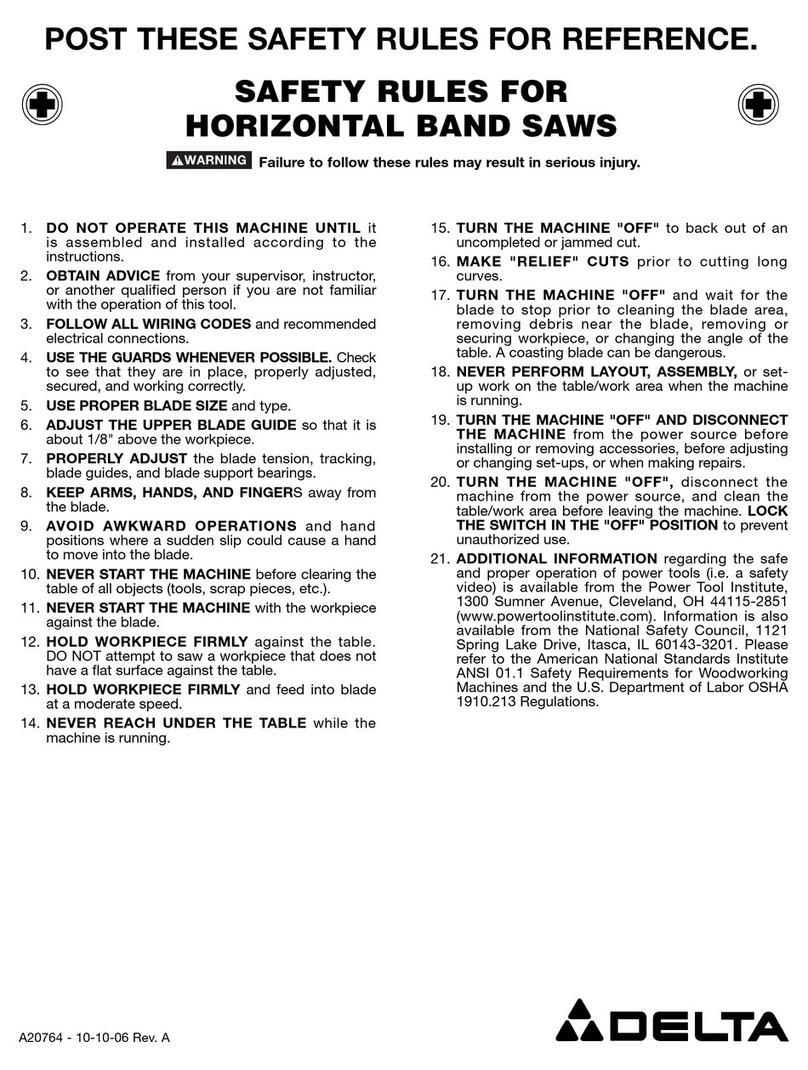
Delta
Delta Horizontal Band Saw User guide
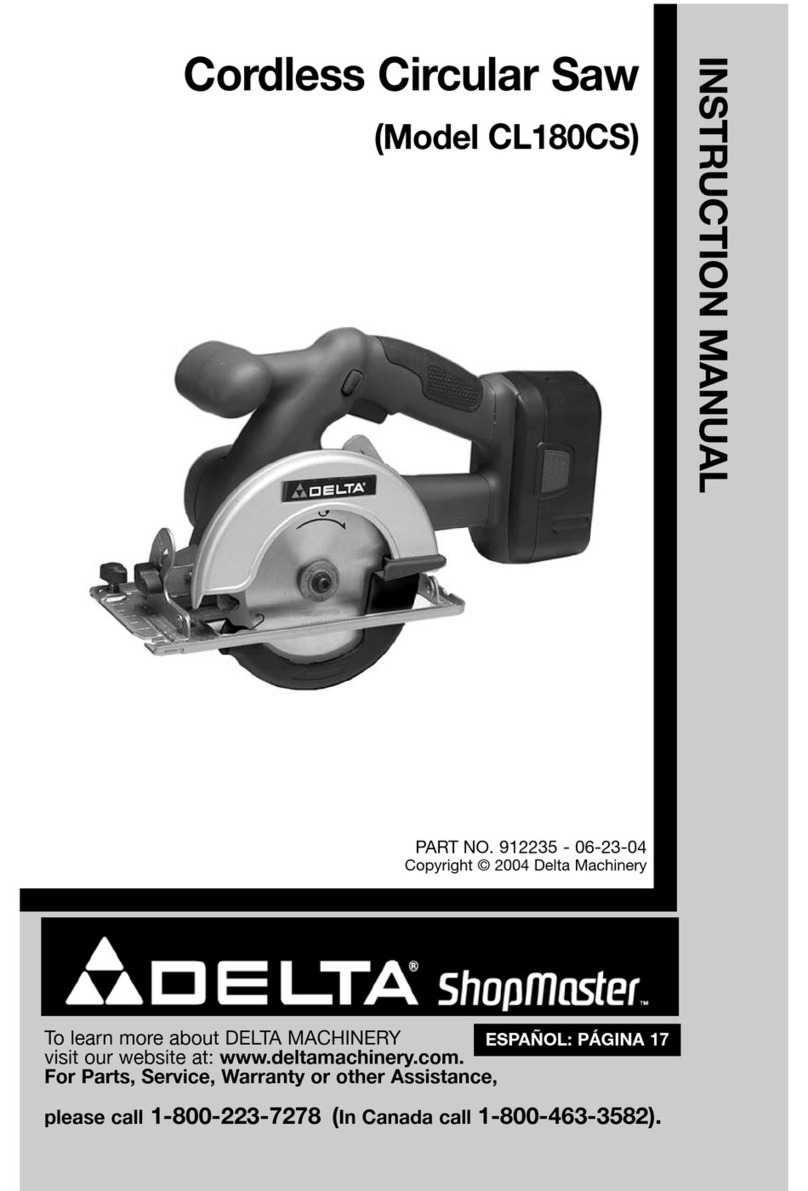
Delta
Delta CL180CS User manual

Delta
Delta ShopMaster TS300 User manual
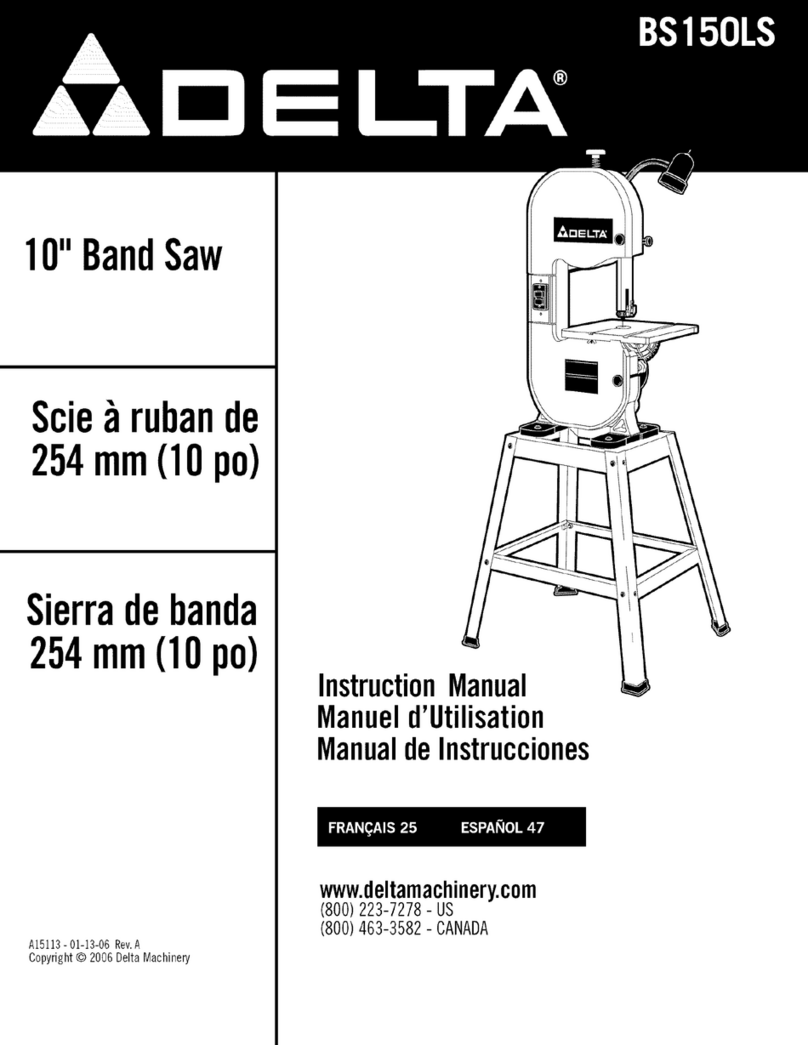
Delta
Delta ShopMaster BS150LS User manual
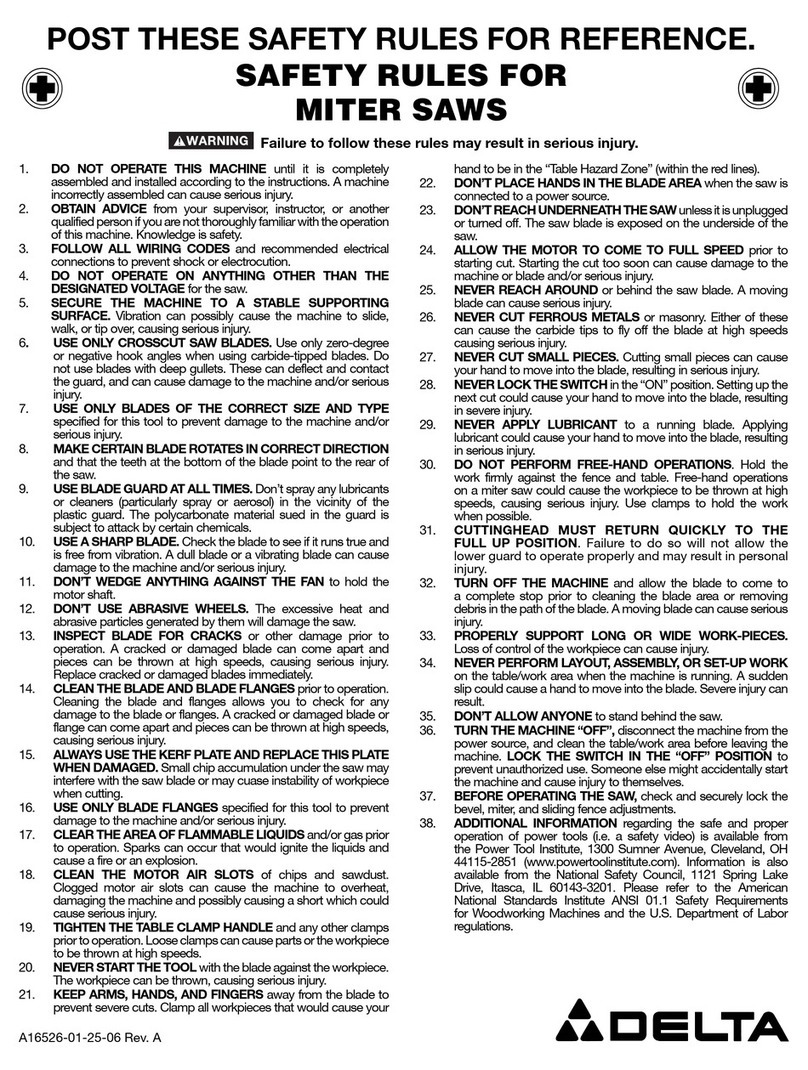
Delta
Delta Miter Saws User guide
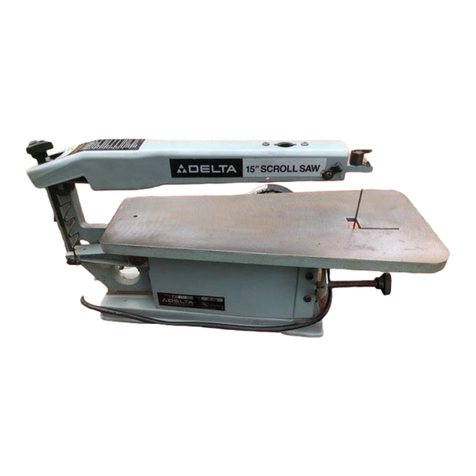
Delta
Delta 15'' scroll saw User manual

Delta
Delta ShopMaster S26-272L User manual
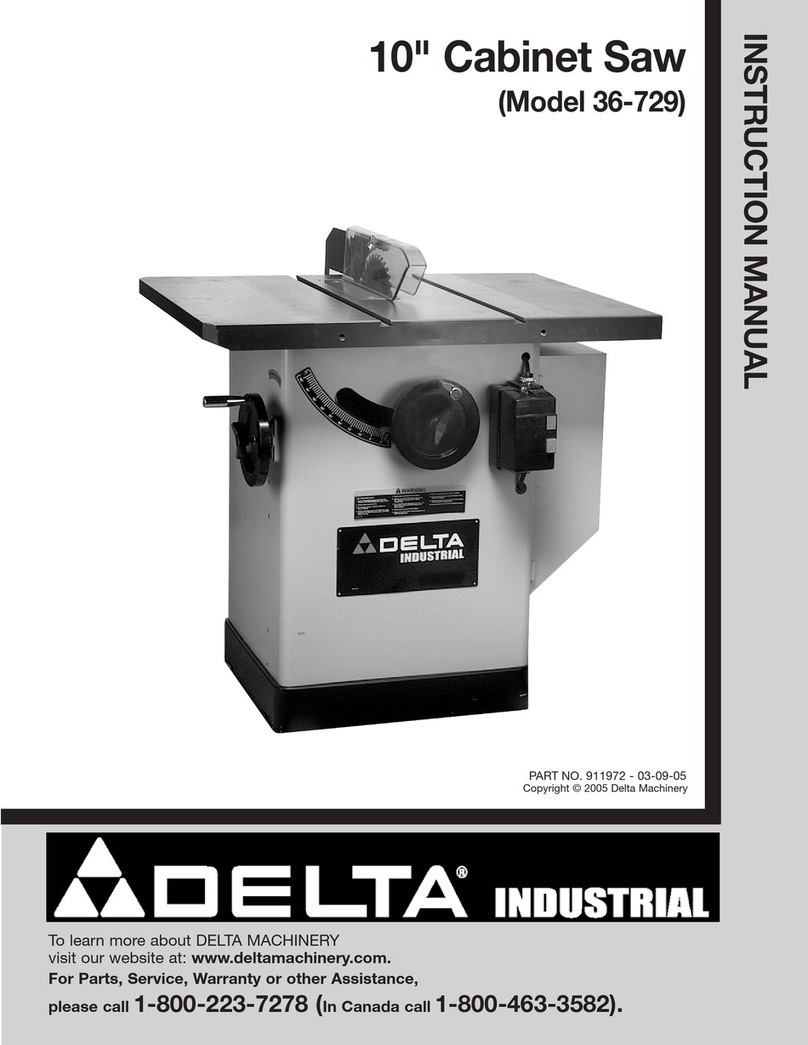
Delta
Delta 36-729 User manual
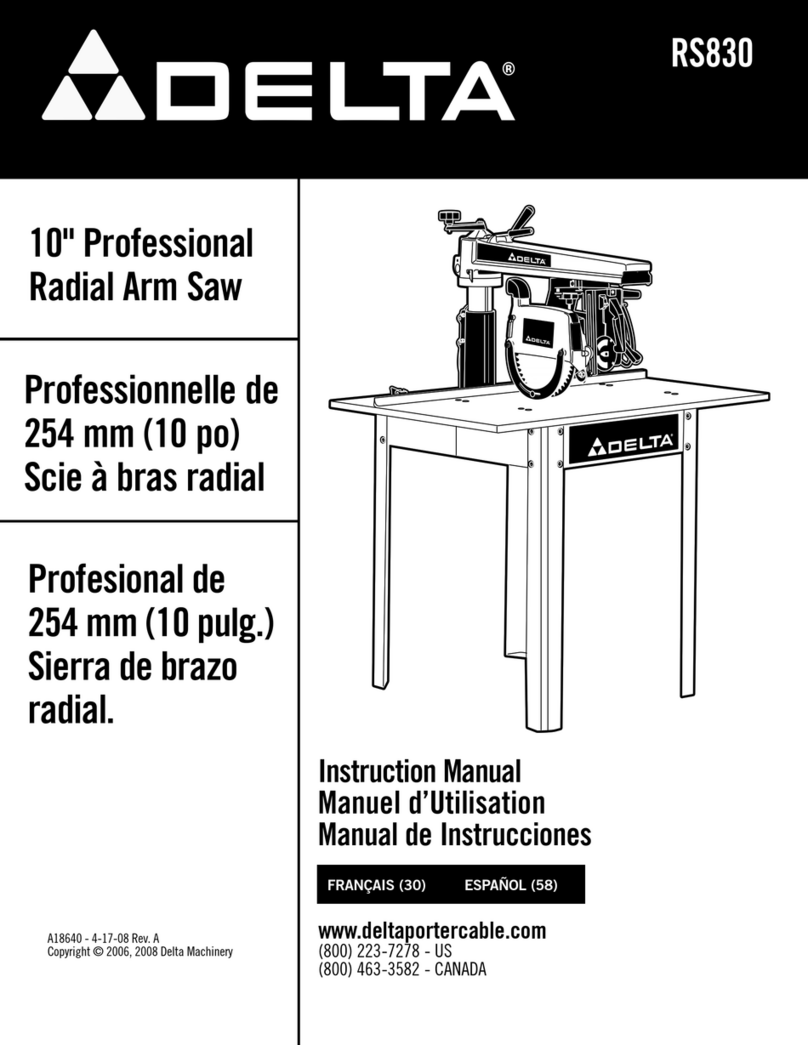
Delta
Delta RS830 User manual
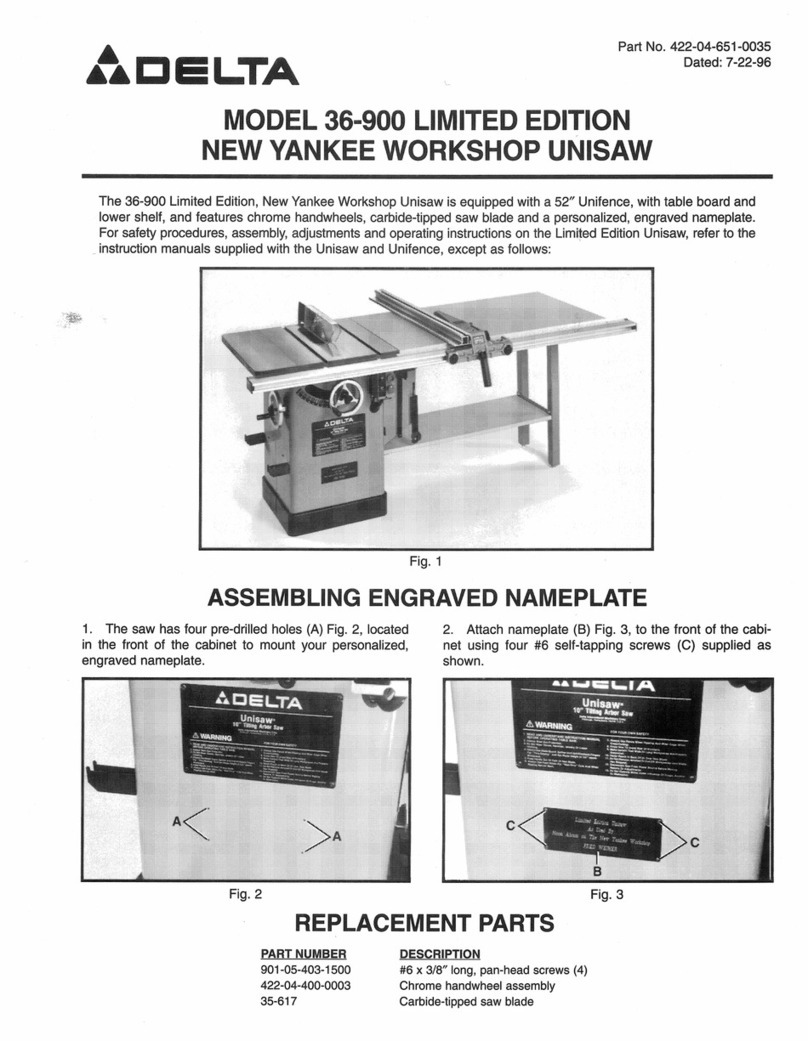
Delta
Delta Unisaw 36-900 User manual

Delta
Delta Platinum Edition 28-263 User manual
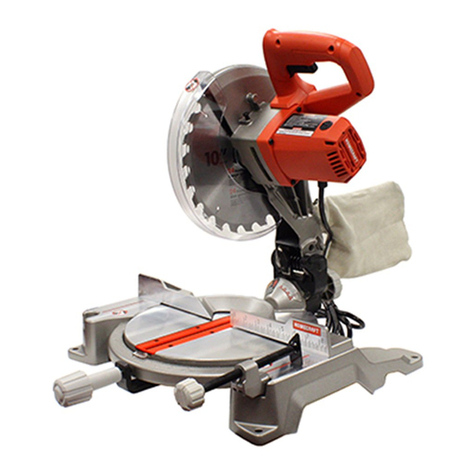
Delta
Delta HOMECRAFT H26-260L User manual

Delta
Delta 36-075 User manual
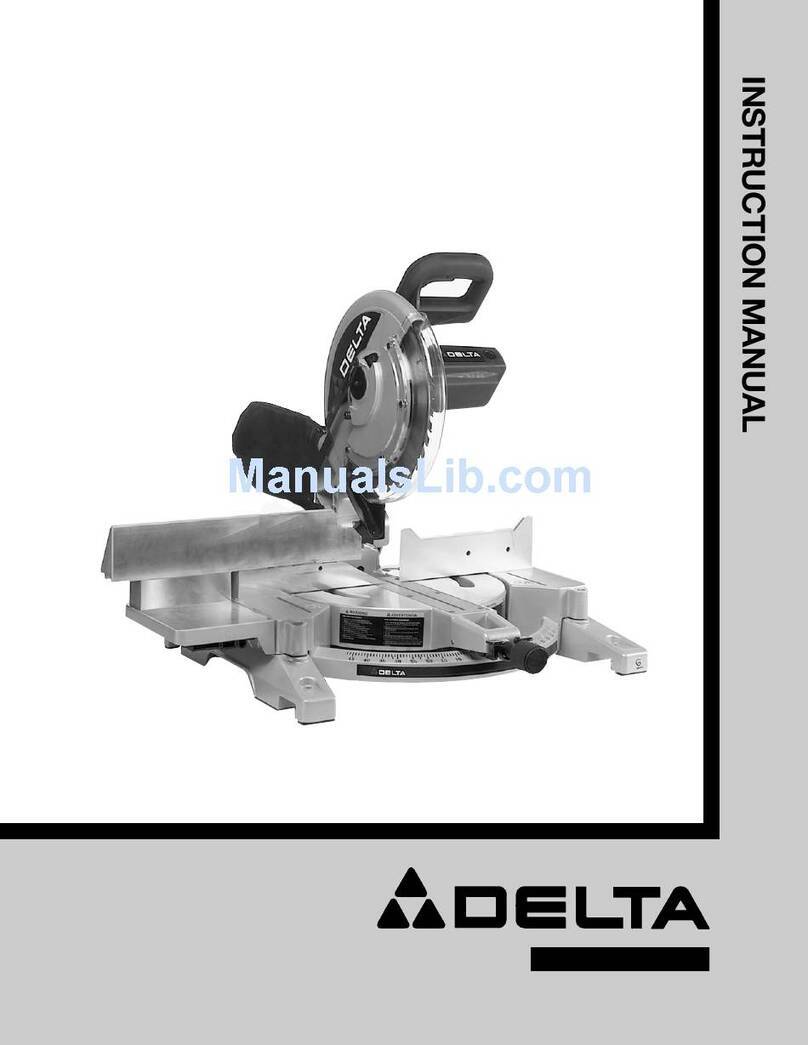
Delta
Delta 36-255 User manual

Delta
Delta 26-2240 User manual
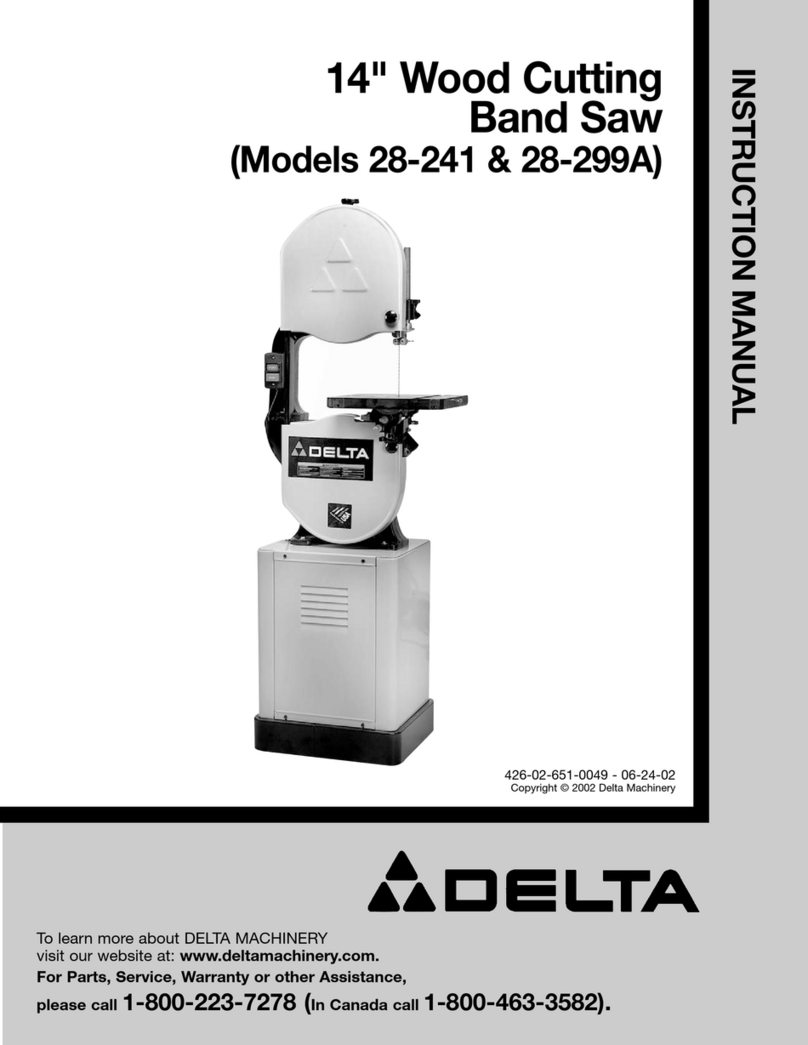
Delta
Delta 28-241 User manual
